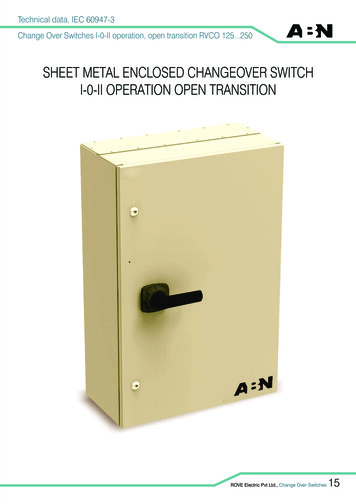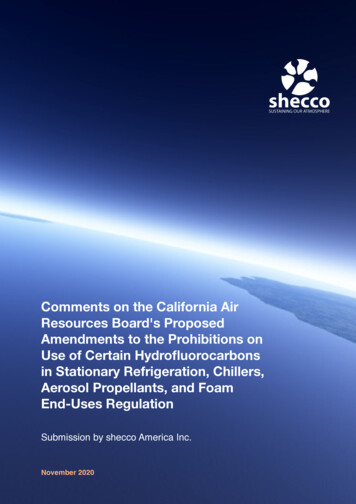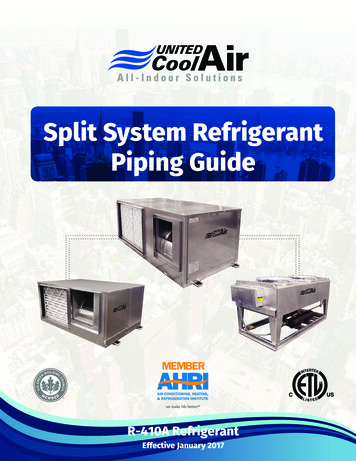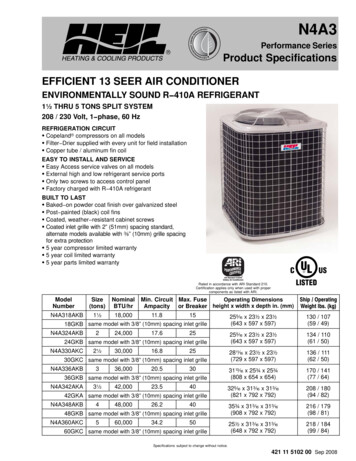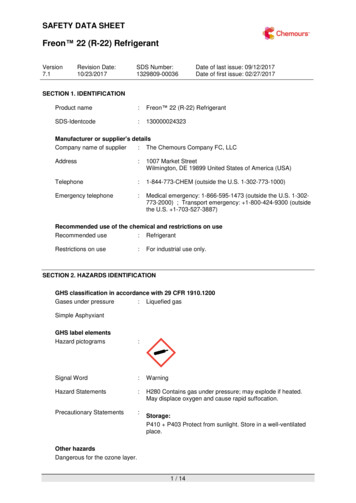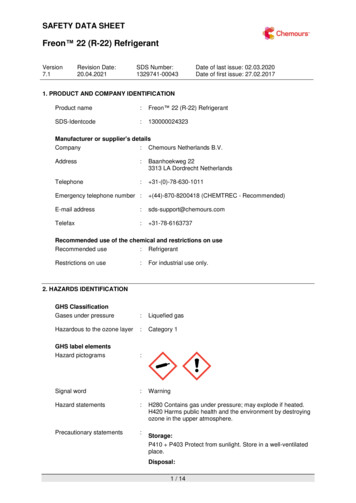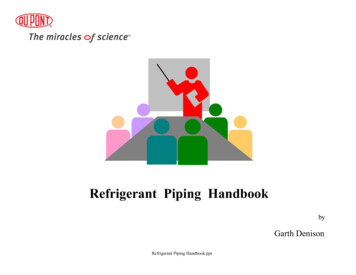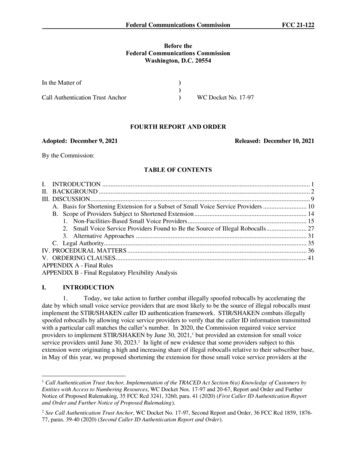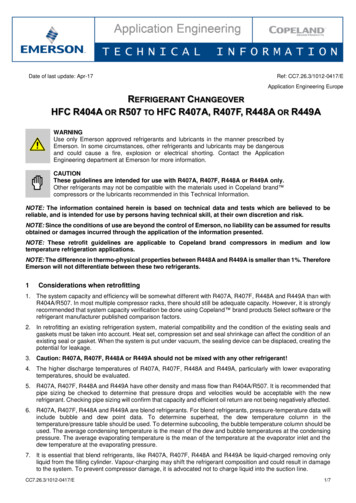
Transcription
Date of last update: Apr-17Ref: CC7.26.3/1012-0417/EApplication Engineering EuropeREFRIGERANT CHANGEOVERHFC R404A OR R507 TO HFC R407A, R407F, R448A OR R449AWARNINGUse only Emerson approved refrigerants and lubricants in the manner prescribed byEmerson. In some circumstances, other refrigerants and lubricants may be dangerousand could cause a fire, explosion or electrical shorting. Contact the ApplicationEngineering department at Emerson for more information.CAUTIONThese guidelines are intended for use with R407A, R407F, R448A or R449A only.Other refrigerants may not be compatible with the materials used in Copeland brand compressors or the lubricants recommended in this Technical Information.NOTE: The information contained herein is based on technical data and tests which are believed to bereliable, and is intended for use by persons having technical skill, at their own discretion and risk.NOTE: Since the conditions of use are beyond the control of Emerson, no liability can be assumed for resultsobtained or damages incurred through the application of the information presented.NOTE: These retrofit guidelines are applicable to Copeland brand compressors in medium and lowtemperature refrigeration applications.NOTE: The difference in thermo-physical properties between R448A and R449A is smaller than 1%. ThereforeEmerson will not differentiate between these two refrigerants.1Considerations when retrofitting1. The system capacity and efficiency will be somewhat different with R407A, R407F, R448A and R449A than withR404A/R507. In most multiple compressor racks, there should still be adequate capacity. However, it is stronglyrecommended that system capacity verification be done using Copeland brand products Select software or therefrigerant manufacturer published comparison factors.2. In retrofitting an existing refrigeration system, material compatibility and the condition of the existing seals andgaskets must be taken into account. Heat set, compression set and seal shrinkage can affect the condition of anexisting seal or gasket. When the system is put under vacuum, the sealing device can be displaced, creating thepotential for leakage.3. Caution: R407A, R407F, R448A or R449A should not be mixed with any other refrigerant!4. The higher discharge temperatures of R407A, R407F, R448A and R449A, particularly with lower evaporatingtemperatures, should be evaluated.5. R407A, R407F, R448A and R449A have other density and mass flow than R404A/R507. It is recommended thatpipe sizing be checked to determine that pressure drops and velocities would be acceptable with the newrefrigerant. Checking pipe sizing will confirm that capacity and efficient oil return are not being negatively affected.6. R407A, R407F, R448A and R449A are blend refrigerants. For blend refrigerants, pressure-temperature data willinclude bubble and dew point data. To determine superheat, the dew temperature column in thetemperature/pressure table should be used. To determine subcooling, the bubble temperature column should beused. The average condensing temperature is the mean of the dew and bubble temperatures at the condensingpressure. The average evaporating temperature is the mean of the temperature at the evaporator inlet and thedew temperature at the evaporating pressure.7. It is essential that blend refrigerants, like R407A, R407F, R448A and R449A be liquid-charged removing onlyliquid from the filling cylinder. Vapour-charging may shift the refrigerant composition and could result in damageto the system. To prevent compressor damage, it is advocated not to charge liquid into the suction line.CC7.26.3/1012-0417/E1/7
Due to the different liquid density and weight of R407A, R407F, R448A and R449A, the refrigerant charge canbe different from the initial charge of R404A/R507.8. Unlike pure fluids and azeotropes, blends boil and condense at varying temperatures for a given pressure. Therange over which the temperature varies is referred to as temperature glide. R407A, R407F, R448A and R449Ahave a temperature glide between 3K and 6K.9. Polyolester lubricant in use with R404A/R507 is suitable for use with R407A, R407F, R448A and R449A. If thelubricant is contaminated or an acid test indicates high levels of acidity, then a lubricant change is required.Approved lubricants for Copeland brand products are Emkarate RL32 3MAF and Mobil Arctic EAL 22CC.10. Compressor suction and discharge pressures for R407A, R407F, R448A and R449A differ from R404A/R507. Itmay be necessary to reset the pressure cut-outs to suit the different pressures of the replacement refrigerant.This procedure should be done carefully to avoid exceeding the recommended operating limits of thecompressor. Pressure regulators may have to be reset. Contact the manufacturer for correct settings.11. Systems that use a low-pressure controller to maintain space temperature may need to have the cut-in and cutout points changed and need adjustment.12. Due to the differences in temperature glide, capacity and mass flow, a new thermostatic expansion valve forR407A, R407F, R448A and R449A is recommended and superheat must be checked after operation. Consultthe TXV manufacturer for correct sizing and superheat settings.13. Copeland semi-hermetic and scroll compressors in low-temperature applications with R407A, R407F, R448A orR449A may require liquid injection, vapour injection or wet vapour injection. The approved and valid applicationenvelopes should be checked in the compressor technical data – see Select software atwww.emersonclimate.eu.NOTE: For more details about liquid injection, vapour injection or wet vapour injection, please refer toTechnical Information C7.19.2 "ZF* Refrigeration Scroll Compressors using R407A, R407F, R448A orR449A in low temperature applications" and D7.19.2 "Demand Cooling for Copeland StreamCompressors with Demand Cooling Driver (XEV01D)".14. Filter-driers must be changed at the time of conversion. They should have an equilibrium point of dryness (EPD)of 50 ppm or lower. 2Solid core driers such as Emerson ADK are compatible with either R404A/R507 or R407A, R407F, R448A,R449A.Compacted bead type driers such as the Emerson FDB series are also compatible.Loose fill-type driers are not recommended and should be replaced with the types referenced above.Changeover procedureBefore starting the changeover, at least the following items should be readily available: Safety glassesGlovesRefrigerant service gaugesElectronic thermometerVacuum pump capable of pulling 0.3 mbarLeak detectorRefrigerant recovery unit including refrigerant cylinderProper container for removed lubricantNew liquid control deviceReplacement liquid line filter-drier(s)New POE lubricant, if neededR407A, R407F, R448A, R449A pressure temperature chartR407A, R407F, R448A or R449A refrigerant1. Record baseline data on original system R404A/R507 performance with the system operating under stableconditions. The following should be recorded as a minimum with R404A/R507 still in the system: compressor inlet and outlet pressures and temperatures; outdoor temperature and liquid temperature, preferably near the expansion valve inlet.CC7.26.3/1012-0417/E2/7
This will enable superheat, subcooling and pressure ratio to be determined and provide the base data forcomparison when the system is put back into operation with the R407A, R407F, R448A or R449A.2. Disconnect electrical power to system.3. Properly remove the R404A/R507 from the system. The refrigerant charge should be isolated from the systemby pumping it down into the receiver enabling the bulk of the charge to be quickly transferred to the recoverycylinder. In all cases the refrigerant must be finally removed from the system using a recovery machine capableof meeting or exceeding the required levels of evacuation. The charge must be collected in a recovery cylinder.Do not vent the refrigerant. Measure and note the amount removed. Knowing the recommended R404A/R507refrigerant charge size for the system is helpful. In all cases weigh the entire amount of removed refrigerant. Thisamount can be used as a guide for the internal quantity of the R407A, R407F, R448A or R449A refrigerant to becharged to the system.4. Replace the liquid line filter-drier with one that is compatible with R407A, R407F, R448A or R449A.5. If the polyolester oil is contaminated or an acid test indicates high levels of acidity, then a lubricant change isrequired. If affected, drain the existing lubricant from the compressors, separators and oil reservoirs. Measurethe amount (volume) of lubricant removed. Change lubricant filters if present. Recharge the system withpolyolester lubricant, use the same amount (volume) as was removed.6. Change the expansion devices; refer to the valve manufacturer’s recommendations.7. Evacuate the system to 0.3 mbar. A vacuum decay test is suggested to ensure that the system is dry and leakfree. Use normal service practices to reconnect and evacuate the system. To remove air and other noncondensables, it is recommended to evacuate the system from both sides. Attempting to evacuate a system withthe pump connected only to the low side of the system will not adequately remove moisture and noncondensables such as air. Use a good electronic gauge to measure the vacuum. An accurate reading cannot bemade with a refrigeration gauge.8. Check the system for leaks using normal service practices.9. Recharge the system with R407A, R407F, R448A or R449A. Remove only liquid from the charging cylinder. Firstcharge should be approximately 85% of the R404A charge by weight. Record the amount of refrigerant charged.10. Check system operation and operating controls. Start the system and allow conditions to stabilize. The dischargepressure of R407A, R407F, R448A or R449A can be different from R404A and condenser fan and ambientcontrols may require adjustment.11. Adjust refrigerant charge.12. Operate the system. Record the data and compare with the data recorded at step 1. Change TXV and adjustTXV superheat setting if necessary. Make adjustments to other controls as needed.13. Properly label the components. Tag the compressor with the refrigerant (R407A, R407F, R448A or R449A) andlubricant used.CC7.26.3/1012-0417/E3/7
3Pressure/Temperature BubbleDewBubbleDewBubbleDewBubblebar(g) C C C C C C C C C 6.3/1012-0417/E4/7
DewBubbleDewBubbleDewBubblebar(g) C C C C C C C C C /E5/7
DewBubbleDewBubbleDewBubblebar(g) C C C C C C C C C 231.931.031.034.93
R407A, R407F, R448A, R449A pressure temperature chart R407A, R407F, R448A or R449A refrigerant 1. Record baseline data on original system R404A/R507 performance with the system operating under stable conditions. The following should be recorded as a minimum with R404A/R507 still in the system: compressor inlet and outlet pressures and temperatures; outdoor temperature and liquid temperature .
